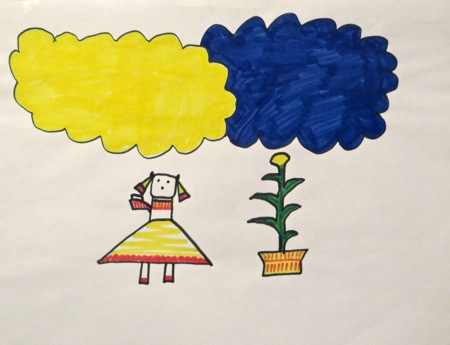Here’s the first installment of an abridged version of the Diné bahané, or Navajo creation story, that I put together for a small class of 5th and 6th graders a couple of years ago. This version of the Diné bahané is adapted from a public domain source edited by Aileen O’Bryan, The Dîné: Origin Myths of the Navaho Indians, Bulletin 163 of the Bureau of American Ethnology of the Smithsonian Institution, (1956), pp. 1-13. (It’s in the public domain because it is a U.S. government document.)
When I presented the Diné bahané to the 5th and 6th graders, they were fascinated. They quickly noticed this story is very different from the two creation stories most familiar to Western culture, the creation story in the Bible where God creates the universe in seven days, or the creation story of ancient Greece in which the universe comes into being from Xaos (Chaos). They also noticed the story has a different understanding of gender roles, particularly in light of the character of Turquoise Boy, who is of ambiguous gender (who will appear in a later installment). They also noticed that this story does not assume such a strong distinction between humans and other animals, as do the Western creation stories. Reading such a different creation story helps us to reflect on the dominant stories in our own culture.
Here, then, is my abridged version of the Diné bahané:
Introduction
The Diné bahané is the traditional Navajo creation story. This long story has never been written down by the Navajos, even though it is as long as a book. Instead, there are people who have memorized the story, and who retell it to others. This version of the Navajo creation story that you’re about to read came to be as follows:
These stories were told to Sandoval, Hastin Tlo’tsi hee, by his grandmother, Esdzan Hosh kige. Her ancestor was Esdzanata’, the medicine woman who had the Calendar Stone in her keeping. Sandoval told these stories to Aileen O’Bryan at Mesa Verde in 1928, and she wrote them down. Here are the stories of the Four Worlds that had no sun, and of the Fifth, the world we live in, which some call the Changeable World.

Above: Illustration of First Man and First Woman drawn by a child in the UUCPA Sunday school, after having seen images of Navajo rugs and sand paintings.
1. The First World
The First World, Ni’hodilqil, — which was also called Red Earth, One Speech, Floating Land, and One Tree — was black as black wool. It had four corners, and over these appeared four clouds. These four clouds contained within themselves the elements of the First World. They were in color, black, white, blue, and yellow.
The Black Cloud represented the Female Being. For as a child sleeps when being nursed, so life slept in the darkness of the Female Being. The White Cloud represented the Male Being or Substance. He was the Dawn, the Light-Which-Awakens, of the First World.
In the East, at the place where the Black Cloud and the White Cloud met, First Man, Atse’hastqin, was formed; and with him was formed the white corn, perfect in shape, with kernels covering the whole ear. Dolionot i’ni is the name of this first perfect seed corn, and it is also the name of the place where the Black Cloud and the White Cloud met.
The First World was small in size, a floating island in mist or water. On it there grew one tree, a pine tree, which was later brought to the present world for firewood.
But human beings had not yet evolved to their present form. The creatures of the First World were the Mist People. They had no definite form, but evolved to change to humans, beasts, birds, and reptiles of this world. There was a male and a female being who were to become man and woman.
Now on the western side of the First World, in a place that later was to become the Land of Sunset, there appeared the Blue Cloud, and opposite it there appeared the Yellow Cloud. Where they came together First Woman was formed, and with her the yellow corn. This ear of corn was also perfect. With First Woman there came the white shell and the turquoise and the yucca.
First Man stood on the eastern side of the First World. He represented the Dawn and was the Life Giver. First Woman stood opposite in the West. She represented Darkness and the End of Life.
First Man burned a crystal for a fire. First Woman burned her turquoise for a fire. They saw each other’s lights in the distance. When the Black Cloud and the White Cloud rose higher in the sky First Man set out to find the turquoise light. He went twice without success, and again a third time; then he broke a forked branch from his tree, and, looking through the fork, he marked the place where the light burned. And the fourth time he walked to it and found smoke coming from a home.
“Here is the home I could not find,” First Man said.
First Woman answered: “Oh, it is you. I saw you walking around and I wondered why you did not come.”

Above: Illustration of First Woman by a child in the UUCPA Sunday school, based on photos of Navajo rugs.
